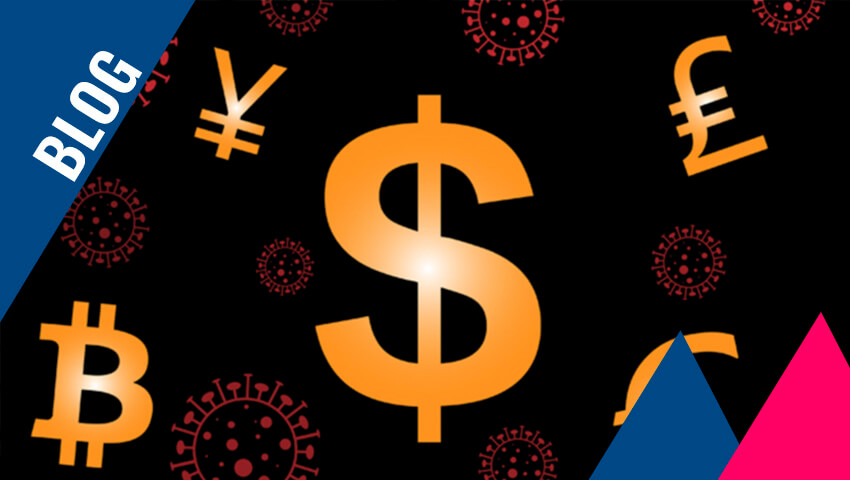
Pandemic Financing – Stealing Billions from Future Generations

Key Takeaways
- Governments borrow money to finance crises by selling government ‘bonds’; which are ‘promises’ to repay borrowed money, plus interest to those who buy them.
- However, these bond issues will be less in demand if traditional investors in bonds find that investing in new equity offerings and/or buying existing shares has a better risk-return in a highly depressed share market.
- When demand in bonds fall, central banks boost demand by buying the bonds themselves.
- This is called Quantitative Easing (QE), or colloquially ‘money printing’.
- QE keeps interest rate down in the bond market.
- In Australia, as the government bond interest rates are low, the interest bill on the additional $213 billion of pandemic crisis borrowings will be just $1.6 billion a year, which will be added to the net-debt of the country.
- Repaying this net-debt will be the responsibility of future generations; which will take a long, long time, if ever.
- To reduce the burden on future generations, countries responsible for the COVID-19 pandemic could, under international law, be asked to pay reparations; i.e. compensation for damages or economic loss; but such actions may lead to tensions between nations, potentially war, and perhaps exacerbate the current trade wars.
- Protecting future generations from debt shock through increased economic activity seems to be the only workable solution in the short to medium term.
However, governments should be wary that such increased activity, if not controlled, could result in an inhospitable climate for the future generations.
In normal times the governments like to ‘balance the budget’, i.e. balance incoming money from tax collections and other government revenue streams with outgoing spending on welfare, health services, education, security, etc.
When government spends more money than it raises in a year it is called a ‘deficit budget’, and conversely, a ‘surplus budget’ means the annual budget has surpluses of estimated collections vs. estimated expenditures. Government debt is incurred and accumulated when there are deficits; whilst surpluses are used to partially reduce accumulated debt. With enough annual surpluses, the debt can be eliminated altogether.
But a global pandemic is not normal times.
In a recent article, Irvine (2020) gives an excellent overview of where will all the money come from to fund the stimulus packages such as offered by countries such as USA, UK and Australia.[i] Whilst none of these countries have come even close to eliminating the national debt accumulated in previous downturns and crises – especially during the global financial crisis (GFC) – their economic growth has been so rapid since the GFC as to dwarf the size of their debt relative to their national income.
For example, prior to the pandemic, the Australian government net debt was, in dollar terms, higher than at any other time in its history; but as a percentage of its economy, however, the net debt was about 19.2 per cent of gross domestic product; i.e. the same as it was in the mid-1990s, in the aftermath of the early ’90s recession (Irvine, 2020).
Now, however, the Australia net debt can be expected to top half a trillion dollars, as the Federal government needs to borrow money to finance the various stimulus packages it is offering for its population to practice ‘social distancing’.
How the Government Gets the Money
Governments borrow money in various ways. It sells ‘Australian Government Bonds’. These are ‘government promises’ to repay borrowed money, plus interest, to those who buy them. There are two types of Bonds available: Treasury Bonds which provide fixed interest payments; and Treasury Indexed Bonds which provide interest payments linked to inflation. As one can see, as more and more bonds are issued and the level of outstanding government debt rises, and so too will the total interest bill that must be paid out to those investing in the bonds. The Australian government paid $14 billion in net interest payments on its borrowings in the last financial year.
Who invests in these bonds? Irvine (2020) states that according to the Australian Office of Financial Management (AOFM), just over half of Australian government bonds are held by non-residents. These include foreign banks, central banks and investors, including big global pension funds. The remainder is held by Australian entities, including banks, super funds and other institutional investors.
Although Australian government bonds have tended to be oversubscribed in the past, it is still to be seen if regular investors in such bonds will have the cash to invest in such an unprecedented global pandemic. Their behaviour in past crisis situations indicate that they would. Even during the global GFC, as big pension funds still continued to receive a steady stream of contributions from the employed workers; they purchased bonds as they needed somewhere to park the money.
However, today we are in a situation where a much larger percentage of the workers are ‘unemployed’ and not making any pension fund contributions.[ii] These pension funds may need the cash to continue to pay the retired members their ‘pensions’. Many governments are also passing legislation for cash-strapped workers to access their fund balances.
Further, if the (risk-free) return offered in the government bonds is extremely low; potential investors may decide that snapping-up blue-chip shares (equity) at depressed prices provides the potential of a much better future return than the very low interest rates offered in the government bond market. Of course, the share market has a risk attached to it, but if the expected risk premium (i.e. the difference between the expected market return and the risk-free rate) is large enough, the risk-return trade-off may tilt the investors away from the bond market.
Also, we have seen companies making very successful private equity capital raisings (new shares).
The Role of Private Equity
Private equity is raised by companies, not governments. Cash going into private equity is cash lost to government bonds.
Companies issue new shares, called ‘equity placements’ when they want to raise cash. In a pandemic crisis, cash is needed fast to keep operations going. However, there are rules in new equity capital raisings which take time to adhere to; and companies, especially mid-sized companies, do not have the luxury of time.
In the last 3 days of March 2020, in response to the COVID-19 pandemic, some of these ‘Rules’ were eased in Australia. The Australian Federal Government and the Australian Securities Exchange (ASX) made some unprecedented and significant (although temporary) changes to the regulatory landscape with respect to equity capital raisings in Australia.
Prior to these changes, in simple terms, a foreign non-government investor could buy Australian securities without restrictions if the total ownership did not exceed a 20% threshold. A foreign investor could still exceed 20% if the total investment was under a monetary threshold of $275 million for business acquisitions (except media) and for of $60 million for agribusiness acquisitions.
Under the temporary changes to Australia’s foreign investment laws, the monetary thresholds have been reduced to nil. This means that any investment over 20% must seek government approval. There appears to be no changes to the rules for investments under the 20% ownership threshold – these can still go ahead. Although the impact of the changes in the foreign investment law on capital raisings by Australian listed entities is expected to be limited; the sudden tightening of the regime may still dampen appetite from offshore investors, who are a key element of Australia’s capital markets.[iii]
The Australian Stock Exchange (ASX) also announced temporary emergency capital raising pertaining to placements, share purchase plans and entitlement offers. One of the concerns that existing shareholders will have is the temporary increase of the annual limit on shares which can be placed with non-shareholders without shareholder approval in any 12-month period. This was lifted from 15% to 25%. Further, the old requirement that you cannot do a pro-rata share issue greater than a 1-for-1 without shareholder approval has now been changed to a 2-for-1. This allows for a larger number of discounted placements to strategic or institutional shareholders, boards and their advisers; and will inevitably dilute retail investors (Chanticleer, 2020).[iv].
As a result of these changes, there has been a spate of equity capital raisings in Australia. Most of the companies lining up for capital to date can be placed in the ‘emergency cash injection’ category such as tourism operators such as Flight Centre ($700 million) and Webjet ($246 million). But eyebrows have been raised about the private equity placement of Cochlear, a large company with good post-coronavirus prospects – albeit one with an expensive $700 million legal settlement hanging over its head. Eyebrows were further raised when it was found that Cochlear is chaired by Mr. Rick Holliday-Smith, who is also the chairman of ASX (that relaxed the rules); and the shares of Cochlear issued at $140 per share were trading at $191 a week later. Thus, those lucky enough to get a big chunk of the new shares, in particular UK fund manager Veritas which picked up about one third of the placement, have made a killing (Knight, 2020).[v]
The big winners were Australia’s investment banks, which collected hefty fees for such placements. The losers were the retail investors, whose shares have been significantly diluted.
The point is, there will be more equity placements to come, sucking money away from bond market.
Quantitative Easing
In such an environment where the risk-return trade-off is favourable to snapping-up existing shares in a depressed stock market; and in which the rules for equity capital raisings of new shares is relaxed; investors may turn away from bidding for Treasury bonds. If there is less demand for the bonds, traditional economics says that the interest rates need to increase to make the bonds attractive.
If the objective is to keep interest rates low, central banks will need to get much more involved in the market for bonds. They would need to add to the demand for such bonds by purchasing Treasury bonds themselves. When central banks get more involved in buying bonds and other debt securities, it is called ‘Quantitative Easing’.
Quantitative easing (QE) is a monetary policy whereby a central bank uses its cash reserves to purchase existing government bonds in secondary markets. Colloquially, QE is known as ‘money printing’, even though it is done by electronically crediting bank accounts and it does not involve actual printing. QE happens when a countries central bank pumps money directly into the economy by buying specified amounts of financial assets from commercial banks and other financial institutions; thus, raising the prices of those financial assets and lowering their interest rate, while simultaneously increasing the money supply.
For example, in the current crisis, it is expected that the Australian Reserve Bank (Australia’s central bank) will need to purchase Australian government bonds in order to increase the demand for such bonds; and consequently, become a bigger owner of Australian government bonds than it has held in the past.
QE differs from the more usual policy of buying or selling government bonds to keep interbank interest rates at a specified target value. QE is a more recent (and unconventional) form of monetary policy, and is usually used when inflation is very low or negative, and standard expansionary monetary policy has become ineffective. Whist one can make a distinction between quantitative easing and credit easing, economists and the media have largely disregarded this by dubbing any effort by a central bank to purchase assets and inflate its balance sheet as quantitative easing.
Printing more money does not increase economic output – it only increases the amount of cash circulating in the economy. If more money is printed, consumers are able to demand more goods, but if firms have still the same amount of goods, they will respond by putting up prices. Thus, in a classical economic supply-demand model, ‘printing money’ should cause rampant inflation. However, this did not happen in the USA.
Between March 2008 and December 2019, the US Federal Reserve (the Fed)’s balance sheet in terms of its total assets, ballooned from US$900 billion to US$4.5 trillion. This was reduced somewhat to US$3 trillion by August 2019. In Sept 2019, the Fed pumped US$75 Billion into the banking system to ease a liquidity shortage; and by March 31, 2020, after the US$2 trillion Coronavirus relief package was added, the Fed’s total assets stood at 5.8 trillion. This is almost double what it was just 7-months ago.
Many investors feared QE would cause runaway prices, but inflation has remained stubbornly low in the USA and around the world. In fact, in places such as Denmark, Japan and Sweden, negative cash rates – and the consequent release of the first -0.5% ten-year fixed rate mortgages – had highlighted a global need to stimulate consumer spending, even before the pandemic crisis.
After the pandemic crisis, many central banks reduced their overnight interbank lending rates. The US Fed reduced the rate to 0.250%; i.e. almost zero. If banks were to reduce their interest rates to below zero, the world of finance as we know it, would flip upside down. Time will have no money value. Savers would pay the banks to hold their money, and borrowers would essentially earn money on the loans they took out.
Protecting Future Generations from Debt Shock
Are future generations paying the price of financing this pandemic crisis? The short answer is “Yes, definitely”.
Whilst it is not ‘impossible’ that net-debt in countries can be significantly reduced or even brought down to zero; it will still take a very, very long time. The government has essentially ‘borrowed’ money from future generations; but as the interest rates are historically low, the annual interest payments will be relatively small. In Australia, the interest bill on the additional $213 billion of crisis borrowings will be just $1.6 billion a year. In the case of any bonds purchased using QE, the government will be paying interest to itself.
One way to reduce the net debt at a faster rate is via reparations.
‘Reparation’ is the act or process of making amends for a wrong. Something done or money paid to make amends or compensate for a wrong. Reparations compensation is paid for damages or economic loss, required from a nation responsible for that damage or loss. After World War II, both West Germany and East Germany were obliged to pay war reparations to the Allied governments, which they paid for by ceding land to Poland and the Soviet Union.
Some organisations such as the Henry Jackson Society, a conservative London think tank, have argued that based on their interpretation of international law, China has breached the International Health Regulations amongst other laws; and therefore should pay compensation due to allegations of their slowness in reacting to and disclosing the virus to other parties (Bourke, 2020).[vi]
The theory of international law states that compliance comes about when there are rational, self-interested sovereign states. International law can affect state behaviour because states are concerned about the reputational and direct sanctions that follow its violation. A failure to honour an international law commitment hurts a state’s reputation because it signals that it is prepared to breach its obligations.
The problem with the actual implementation of international law is that it is more likely to have an impact on events when the stakes are relatively modest. The implication is that many of the issues that receive the most attention in international law – i.e. the laws of war, territorial limits, arms agreements, and so on – are unlikely to be affected by the application of international law should such issues eventuate. On the other hand, issues such as international economic matters, environmental issues, and so on, can more easily be affected by international law (Guzman, 2002).[vii]
Therefore, it would be difficult and controversial to attempt to prosecute China on these allegations and would lead to prolonged court proceedings that would be unlikely to result in them accepting to pay compensation.
It may lead to tensions between nations, potentially war, and perhaps exacerbate the current trade war. For that reason, countries cannot rely on any such a fiscal boost to their financial position and should instead focus on other ways to improve their fiscal position through the tax system and getting the economy back and moving again.
Protecting the Environment of Future Generations
Protecting future generations from debt shock through increased economic activity seems to be the only workable solution in the short to medium term. Such a solution has been successfully implemented before.
After WWII the USA provided more than $15 billion to help finance rebuilding efforts on the European continent under the Marshall Plan. But with the COVID-19 pandemic, with the whole world’s economies, including that of the USA’s, being significantly affected, there appears to be no ‘lender of last resort’. Countries have to rebuild their economies by themselves.
In Australia, prior to the global financial crisis, the Howard government had managed to reduce Australia’s net debt to effectively zero, thanks to the mining boom (Irvin, 2020). Australia was also significantly protected by its mining and resources industry to weather the GFC. Since that time, Australia has relied heavily on the export of its resources. As such, if economic activity surges post-pandemic to meet pent-up demand of a global lockdown, there will be pressure on the Australian government to increase its output and export of its resources, especially coal.
Such boosts in economic activity and in the export of resources may reduce the debt-burden of future generations; but it will come at a significant cost to the environment that these future generations will inherit. The one lesson that COVID-19 has taught us is that we do not need to be a slave to rampant economic growth and excessive consumerism. The ‘lockdown’ is just a precursor to what we will have to go through continuously if a climate disaster eventuates.
In freeing future generations from debt; we should not leave them with a bigger disaster, an inhospitable climate.
The opinions in this article reflect those of the author and not necessarily that of the organisation or its executive
Article by
Prof Janek Ratnatunga

Professor Janek Ratnatunga is CEO of the Institute of Certified Management Accountants. He has held appointments at the University of Melbourne, Monash University and the Australian National University in Australia; and the Universities of Washington, Richmond and Rhode Island in the USA. Prior to his academic career he worked with KPMG.
References:
[i] Jessica Irvine (2020), “Where will all the money come from to fund the stimulus?”, The Sunday Age, Extra, April 5, p.26.
[ii] More than 10 million people applied for unemployment benefits in the last two weeks of March after being thrown out of work by the business shutdowns due the coronavirus pandemic. And the numbers are expecting to keep surging, with some economists predicting the loss of 20 million jobs in the USA alone.
[iii] Baker McKenzie (2020), “Australian Equity Capital Raisings in light of COVID-19”, 01 April,
[iv] Chanticleer (2020), “What the ASX’s emergency changes mean”, Australian Financial Review, April 1, https://www.afr.com/chanticleer/sensible-cap-raise-changes-bring-pain-for-retail-investors-20200331-p54frf
[v] Elizabeth Knight (2020), “Beware the rescue trap for small shareholders”, The Age, Opinion, April 7, p.25. https://www.smh.com.au/business/companies/beware-the-rescue-trap-for-small-shareholders-20200406-p54hjh.html
[vi] Latika Bourke (2020), China should be sued for $6.5 trillion for coronavirus damages says top UK think tank’ The Age, April 6, p.10. https://www.smh.com.au/world/europe/china-should-be-sued-for-6-5-trillion-for-coronavirus-damages-says-top-uk-think-tank-20200405-p54h5b.html
[vii] Andrew T. Guzman (2002), “A Compliance-Based Theory of International Law”, California Law Review, December, Vol. 90, No. 6, pp. 1823-1887.
